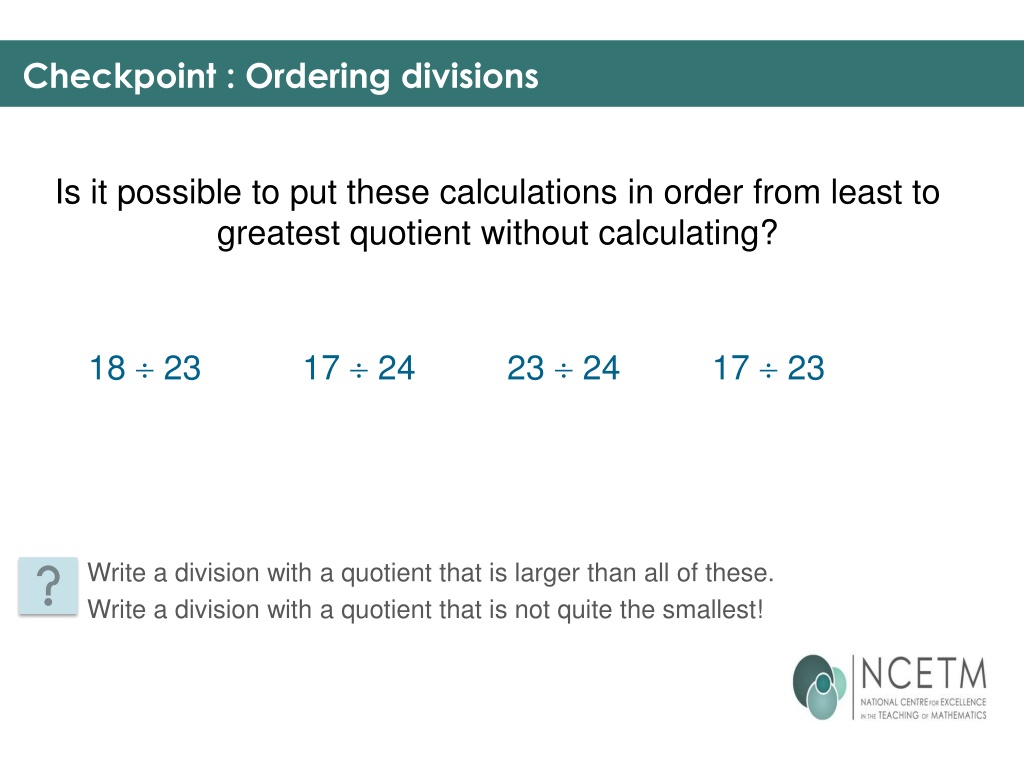Understanding Division & Fractions
Learn about ordering divisions, different methods of division, visualizing division with fractions, and exploring various division calculations involving fractions. Discover how to find quotients, draw diagrams, and understand the relationships between dividends and divisors in fraction divisions.
Download Presentation

Please find below an Image/Link to download the presentation.
The content on the website is provided AS IS for your information and personal use only. It may not be sold, licensed, or shared on other websites without obtaining consent from the author. Download presentation by click this link. If you encounter any issues during the download, it is possible that the publisher has removed the file from their server.
E N D
Presentation Transcript
Checkpoint : Ordering divisions Is it possible to put these calculations in order from least to greatest quotient without calculating? 18 23 17 24 23 24 17 23 Write a division with a quotient that is larger than all of these. Write a division with a quotient that is not quite the smallest!
Division We can think of division in two ways: 6 3 Sharing Grouping 6 baguettes shared equally Split 6 into 2 groups of 3 between 3 people is 2
Division The grouping method is sometimes thought of as how many go into . How many of the divisor fit into the dividend This is how we will think of division when dividing fractions
Dividing Fractions 6 1 = 2 What is the dividend? What is the divisor?
Dividing Fractions 6 1 = 2 What does this calculation mean? s go into 6 ? How many 1 2 6 1 2
Dividing Fractions 5 1 = 3 What does this calculation mean? s go into 5 ? How many 1 3 5 1 3
Dividing Fractions On your whiteboards, draw diagrams to find the quotients: 4 1 3 1. Choose your own example to draw in your books. 5 1 2. Can you generalise? 4 ? 1 8 1 ? 5
Dividing Fractions We know that 4 1 3= 12 What about. 4 2 3 Draw a diagram to find your answer. How does the answer compare to the first answer?
Dividing Fractions On your whiteboards, draw diagrams to find the quotients: 6 2 3 your book. 1. Choose one of these to draw into 2. Why is this question more difficult? Can you find a way to answer it? 6 3 4 5 3 6 2 4 5
Dividing Fractions 2 3 1 = 2 What is the dividend? What is the divisor?
Dividing Fractions 2 3 1 = 2 What does this calculation mean? s go into 2 How many 1 3 ? 2
Dividing Fractions 2 3 1 = 2 How many times does the yellow bar (divisor) fit inside the red bar (dividend)? Discuss in your pairs
Dividing Fractions 2 3 1 2 11 = 3 What fraction of the yellow is this? It s 1 3of the yellow 1 ?
Dividing Fractions 2 3 1 = 2 Another method is to split both bars into sixths. Why sixths? It is easy to see that 11 3 of the yellow fit into the red
Dividing Fractions 1 2 3 = 4 What does this calculation mean? s fit into 1 How many 3 2 4
Dividing Fractions 1 2 3 4 = How many times does the yellow bar fit inside the red bar? Discuss in your pairs
Dividing Fractions 1 2 3 4 2 3 = This is how much of the yellow fits into the red What fraction of the yellow is this?
Dividing Fractions Draw bar representations to help find answers to the following divisions: 5 6 1 1 2 3 3= 5= 7 9 1 2 5 2 6= 3= Finished? Reflect: Look at these four questions and your solutions carefully, write down anything interesting you notice. Which answers are less than 1? Why is this? Convert any mixed number answers to improper fractions What do you notice?
Solutions 5 6 1 21 = 3 2 How many thirds fit in? What fraction of the yellow is this? 2 ?
Solutions 9 1 6 7 42 = 3 How many sixths fit in? 4 ? What fraction of the yellow is this?
Solutions It s hard to compare. Let s split into tenths. Why tenths? 1 2 3 = 5 How much of 3 5 fits into 1 2? ?
Solutions 1 2 3 5 6 = 5 It s very easy to see that 5 the yellow fits into the red 6 of ?
Solutions Again, It s hard to compare. Let s split into fifteenths. 2 5 2 = 3 What fraction of 2 3 fits into 2 5? ?
Solutions 2 5 2 6 = 3 10 What fraction of the yellow is this? ?
Challenges Create fractional division questions with the answer of 3 4 Create fractional division questions with the answer of 22 3
Reflection Look at the four questions and your solutions carefully, write down anything interesting you notice. Which answers are less than 1? Why is this? Convert any mixed number answers to improper fractions What do you notice?























